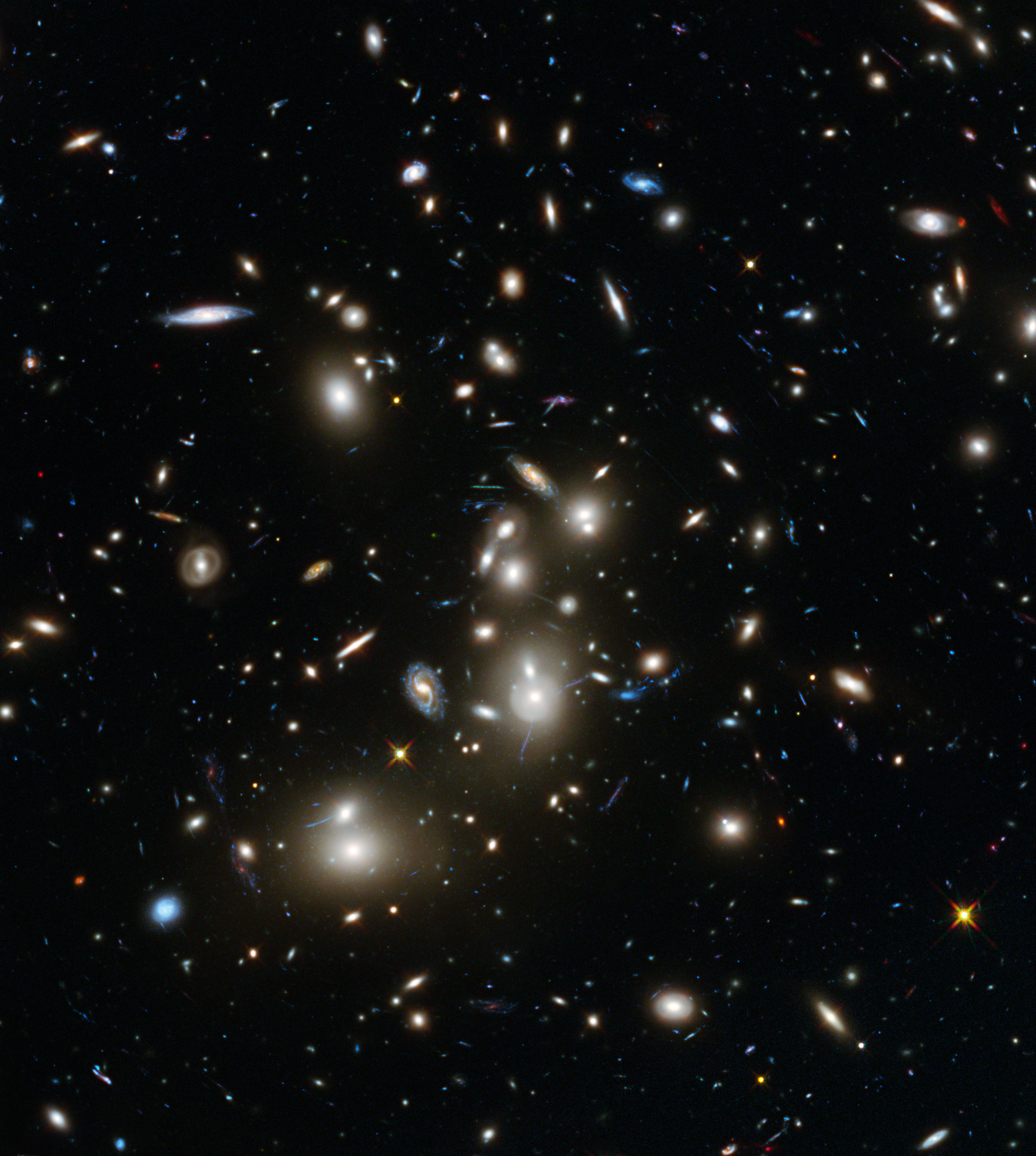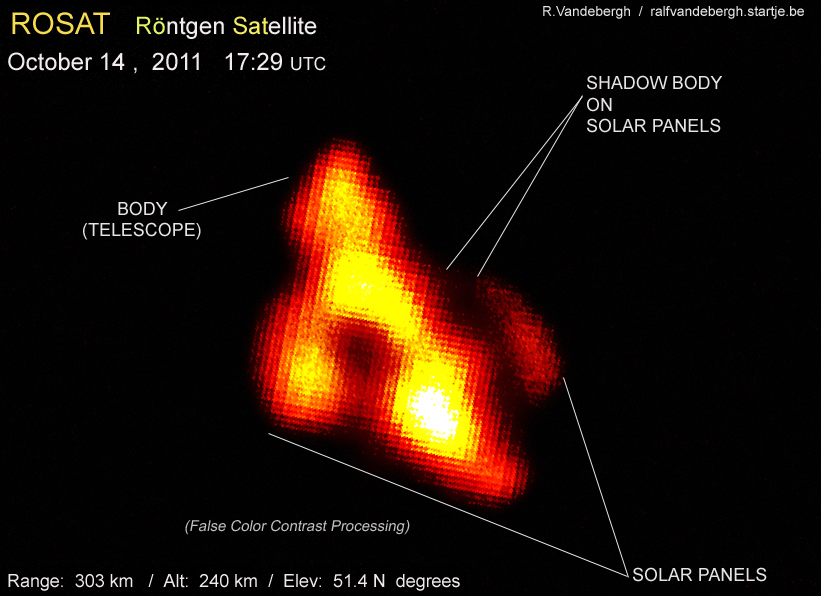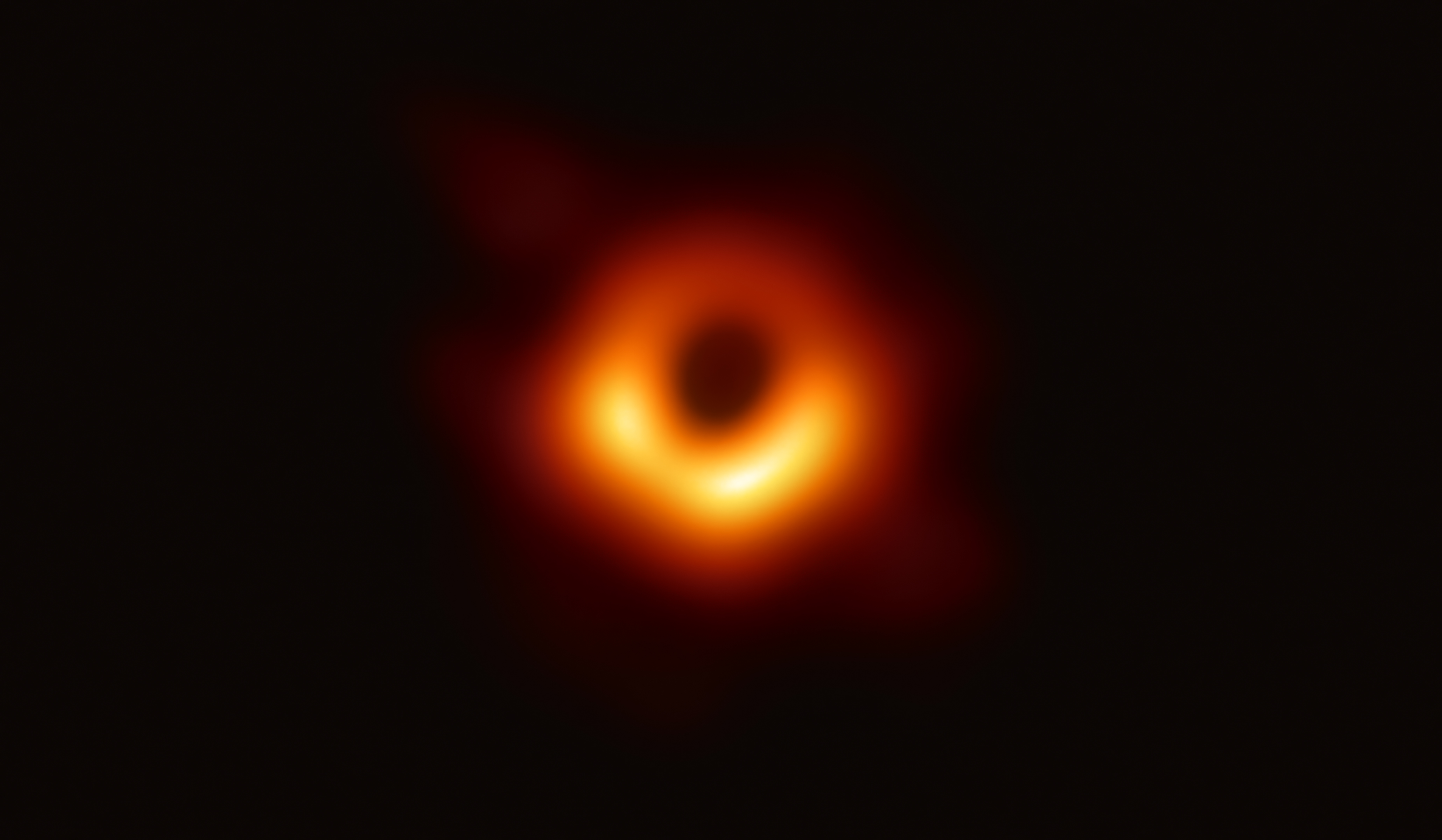|
Abell 2390
Abell 2390 is a massive galaxy cluster located in the constellation Pegasus. It is classified as an X-ray and rich galaxy clusters measured cooling rate of 200-300 Mʘyr−1. The galaxy cluster contains a cD galaxy called Abell 2390 BCG (short for brightest cluster galaxy), associated with a complex radio source, B2151+141. A study has been conducted on the galaxy members of Abell 2390 and finds each of them have different morphology classifications. Further evidence also points out only a few galaxies show star formations, indicating starbursts play no major role in propelling the galaxy cluster's evolution. Based on weak gravitational distortion of galaxies lying in the background, dark matter distribution is detected in Abell 2390. Its X-ray distribution in the cluster is elliptical and distorted by its sub-structure on a large scale according to an X-ray ROSAT/HRI observation. Abell 2390 BCG The brightest cluster galaxy of Abell 2390 is the supergiant elliptical galax ... [...More Info...] [...Related Items...] OR: [Wikipedia] [Google] [Baidu] |
Abell Catalogue
The Abell catalog of rich clusters of galaxies is an all-sky catalog of 4,073 rich galaxy clusters of nominal redshift ''z'' ≤ 0.2. This catalog supplements a revision of George O. Abell's original "Northern Survey" of 1958, which had only 2,712 clusters, with a further 1,361 clustersthe "Southern Survey" of 1989, published after Abell's death by co-authors Harold G. Corwin and Ronald P. Olowin from those parts of the south celestial hemisphere that had been omitted from the earlier survey. The Abell catalog, and especially its clusters, are of interest to amateur astronomers as challenge objects to be viewed in dark locations on large aperture amateur telescopes. The Northern Survey The original catalog of 2,712 rich clusters of galaxies was published in 1958 by George O. Abell (1927–1983), who was then studying at the California Institute of Technology. The catalog, which formed part of Abell's PhD thesis, was prepared by means of a visual inspection of the ... [...More Info...] [...Related Items...] OR: [Wikipedia] [Google] [Baidu] |
ROSAT
ROSAT (short for Röntgensatellit; in German X-rays are called Röntgenstrahlen, in honour of Wilhelm Röntgen) was a German Aerospace Center-led satellite X-ray telescope, with instruments built by West Germany, the United Kingdom and the United States. It was launched on 1 June 1990, on a Delta II rocket from Cape Canaveral, on what was initially designed as an 18-month mission, with provision for up to five years of operation. ROSAT operated for over eight years, finally shutting down on 12 February 1999. In February 2011, it was reported that the satellite was unlikely to burn up entirely while re-entering the Earth's atmosphere due to the large amount of ceramics and glass used in construction. Parts as heavy as could impact the surface. ROSAT eventually re-entered the Earth's atmosphere on 23 October 2011 over the Bay of Bengal. Overview The Roentgensatellit (ROSAT) was a joint German, U.S. and British X-ray astrophysics project. ROSAT carried a German-built imagi ... [...More Info...] [...Related Items...] OR: [Wikipedia] [Google] [Baidu] |
Galaxy Clusters
A galaxy cluster, or a cluster of galaxies, is a structure that consists of anywhere from hundreds to thousands of galaxies that are bound together by gravity, with typical masses ranging from 1014 to 1015 solar masses. Clusters consist of galaxies, heated gas, and dark matter. They are the second-largest known gravitationally bound structures in the universe after superclusters. They were believed to be the largest known structures in the universe until the 1980s, when superclusters were discovered. Small aggregates of galaxies are referred to as galaxy groups rather than clusters of galaxies. Together, galaxy groups and clusters form superclusters. Basic properties Galaxy clusters typically have the following properties: * They contain 100 to 1,000 galaxies, hot X-ray emitting gas and large amounts of dark matter. Details are described in the "Composition" section. * They have total masses of 1014 to 1015 solar masses. * They typically have diameters from 1 to 5 Mpc ( ... [...More Info...] [...Related Items...] OR: [Wikipedia] [Google] [Baidu] |
Abell Objects
Abell may refer to: People *Abell (surname) *George O. Abell, of the astronomical catalogues fame Places ;United States * Abell, Maryland, a location in St. Mary's County, Maryland * Abell, Baltimore, Abell, a neighborhood in Baltimore, Maryland * Abells Corners, Wisconsin, an unincorporated community Astronomy *Abell catalogue of rich clusters of galaxies (ACO) *Abell Catalog of Planetary Nebulae (A) Bibliographical database *ABELL, the ''Annual Bibliography of English Language and Literature'' See also *Abel (other) {{disambiguation, geo ... [...More Info...] [...Related Items...] OR: [Wikipedia] [Google] [Baidu] |
List Of Abell Clusters
The Abell catalogue is a catalogue of approximately 4,000 galaxy clusters with at least 30 members, almost complete to a redshift of ''z'' = 0.2. It was originally compiled by the American astronomer George O. Abell in 1958 using plates from National Geographic Society – Palomar Observatory Sky Survey, POSS, and extended to the southern hemisphere by Abell, Harold Corwin, Corwin and Ronald Olowin, Olowin in 1987. The name "Abell" is also commonly used as a designation for objects he compiled in a catalogue of 86 planetary nebulae in 1966. The proper designation for the galaxy clusters is ACO, as in "ACO 13", while the planetary-nebula designation is the single letter A, as in "A 39". 1–1999 2000–4076 Southern catalogue S1–S1174 See also * Lists of astronomical objects * List of galaxy groups and clusters References External linksAbell's 1958 paper and catalog [...More Info...] [...Related Items...] OR: [Wikipedia] [Google] [Baidu] |
Supermassive Black Hole
A supermassive black hole (SMBH or sometimes SBH) is the largest type of black hole, with its mass being on the order of hundreds of thousands, or millions to billions, of times the mass of the Sun (). Black holes are a class of astronomical objects that have undergone gravitational collapse, leaving behind spheroidal regions of space from which nothing can escape, including light. Observational evidence indicates that almost every large galaxy has a supermassive black hole at its center. For example, the Milky Way galaxy has a supermassive black hole at its center, corresponding to the radio source Sagittarius A*. Accretion of interstellar gas onto supermassive black holes is the process responsible for powering active galactic nuclei (AGNs) and quasars. Two supermassive black holes have been directly imaged by the Event Horizon Telescope: the black hole in the giant elliptical galaxy Messier 87 and the black hole at the Milky Way's center (Sagittarius A*). Descr ... [...More Info...] [...Related Items...] OR: [Wikipedia] [Google] [Baidu] |
Astrophysical Jet
An astrophysical jet is an astronomical phenomenon where outflows of ionised matter are emitted as extended beams along the axis of rotation. When this greatly accelerated matter in the beam approaches the speed of light, astrophysical jets become relativistic jets as they show effects from special relativity. The formation and powering of astrophysical jets are highly complex phenomena that are associated with many types of high-energy astronomical sources. They likely arise from dynamic interactions within accretion disks, whose active processes are commonly connected with compact central objects such as black holes, neutron stars or pulsars. One explanation is that tangled magnetic fields are organised to aim two diametrically opposing beams away from the central source by angles only several degrees wide Jets may also be influenced by a general relativity effect known as frame-dragging. Most of the largest and most active jets are created by supermassive black holes (SM ... [...More Info...] [...Related Items...] OR: [Wikipedia] [Google] [Baidu] |
Spectral Line
A spectral line is a weaker or stronger region in an otherwise uniform and continuous spectrum. It may result from emission (electromagnetic radiation), emission or absorption (electromagnetic radiation), absorption of light in a narrow frequency range, compared with the nearby frequencies. Spectral lines are often used to identify atoms and molecules. These "fingerprints" can be compared to the previously collected ones of atoms and molecules, and are thus used to identify the atomic and molecular components of stars and planets, which would otherwise be impossible. Types of line spectra Spectral lines are the result of interaction between a Quantum mechanics, quantum system (usually atoms, but sometimes molecules or atomic nucleus, atomic nuclei) and a single photon. When a photon has about the right amount of photon energy, energy (which is connected to its frequency) to allow a change in the energy state of the system (in the case of an atom this is usually an electron cha ... [...More Info...] [...Related Items...] OR: [Wikipedia] [Google] [Baidu] |
Radio Galaxy
A radio galaxy is a galaxy with giant regions of radio emission extending well beyond its visible structure. These energetic radio lobes are powered by jets from its active galactic nucleus. They have luminosities up to 1039 W at radio wavelengths between 10 MHz and 100 GHz. The radio emission is due to the synchrotron process. The observed structure in radio emission is determined by the interaction between twin jets and the external medium, modified by the effects of relativistic beaming. The host galaxies are almost exclusively large elliptical galaxies. ''Radio-loud'' active galaxies can be detected at large distances, making them valuable tools for observational cosmology. Recently, much work has been done on the effects of these objects on the intergalactic medium, particularly in galaxy groups and clusters. The term "radio galaxy" is often used to refer to the entire jet system, rather than solely to its host galaxy. Some scientists consider the term " ... [...More Info...] [...Related Items...] OR: [Wikipedia] [Google] [Baidu] |
Fanaroff–Riley Classification
The Fanaroff–Riley classification is a scheme created by B.L. Fanaroff and J.M. Riley in 1974, which is used to distinguish radio galaxies with active nuclei based on their radio luminosity or brightness of their radio emissions in relation to their hosting environment. Fanaroff and Riley noticed that the relative positions of high/low surface brightness regions in the lobes of extragalactic radio sources are correlated with their radio luminosity. Their conclusion was based on a set of 57 radio galaxies and quasars that were clearly resolved at 1.4 GHz or 5 GHz into two or more components. Fanaroff and Riley divided this sample into two classes using the ratio of the distance between the regions of highest surface brightness on opposite sides of the central galaxy or quasar to the total extent of the source up to the lowest brightness contour. ''Class I'' (abbreviated FR-I) are sources whose luminosity decreases as the distance from the central galaxy or quasar host ... [...More Info...] [...Related Items...] OR: [Wikipedia] [Google] [Baidu] |
Brightest Cluster Galaxy
A brightest cluster galaxy (BCG) is defined as the brightest galaxy in a cluster of galaxies. BCGs include the List of largest galaxies, most massive galaxies in the universe. They are generally elliptical galaxies which lie close to the geometric and kinematical center of their host galaxy cluster, hence at the bottom of the cluster potential well. They are also generally coincident with the peak of the cluster X-ray emission. Formation scenarios for BCGs include: * Cooling flow—star formation from the central cooling flow in high density cooling centers of X-ray cluster galactic halo, halos. The cooling flow begins due to the entropy in the galaxy falling below a key value. The study of accretion populations in BCGs has cast doubt over this theory and astronomers have seen no evidence of cooling flows in radiative cooling clusters. The two remaining theories exhibit healthier prospects. * Galactic cannibalism—galaxies sink to the center of the cluster due to dynamical fric ... [...More Info...] [...Related Items...] OR: [Wikipedia] [Google] [Baidu] |
Dark Matter
In astronomy, dark matter is an invisible and hypothetical form of matter that does not interact with light or other electromagnetic radiation. Dark matter is implied by gravity, gravitational effects that cannot be explained by general relativity unless more matter is present than can be observed. Such effects occur in the context of Galaxy formation and evolution, formation and evolution of galaxies, gravitational lensing, the observable universe's current structure, mass position in galactic collisions, the motion of galaxies within galaxy clusters, and cosmic microwave background Anisotropy, anisotropies. Dark matter is thought to serve as gravitational scaffolding for cosmic structures. After the Big Bang, dark matter clumped into blobs along narrow filaments with superclusters of galaxies forming a cosmic web at scales on which entire galaxies appear like tiny particles. In the standard Lambda-CDM model of cosmology, the mass–energy equivalence, mass–energy content o ... [...More Info...] [...Related Items...] OR: [Wikipedia] [Google] [Baidu] |







